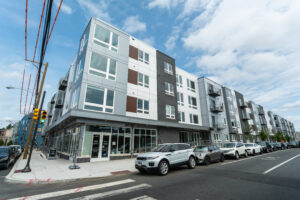Writer: Joey Garrand
 2 min read February 2021 — The pandemic has brought with it many challenges and uncertainties for commercial real estate in the Greater Philadelphia region. However, according to local business leaders, multi-family is performing exceptionally well in the region during this crisis as a lack of inventory and shifting demographics underpin the sector.
2 min read February 2021 — The pandemic has brought with it many challenges and uncertainties for commercial real estate in the Greater Philadelphia region. However, according to local business leaders, multi-family is performing exceptionally well in the region during this crisis as a lack of inventory and shifting demographics underpin the sector.
“Right now our biggest sector is multi-family. Multi-family is booming. We have projects in the pipeline from now until 2024, and we’re currently involved in preconstruction services for many of them at this time,” Dan Gring, CEO of D&B Construction Group, told Invest:.
Other leaders agree.
“In 2020, both multi-family and single-family housing were strong,” said Jim Riviello, principal and partner of The Martin Architectural Group. “The housing stock is still not to levels needed due to the great recession. There is still a backlog of potential buyers for homes. There is also a strong demand by active adult buyers. From the research we’ve been analyzing, 33% of people who are reaching age 55 are on their own, which is much different than what we saw 20 years ago. This has created a strong demand for smaller homes and multi-family condominiums. While we are seeing a good number of $500,000 to $600,000 townhomes being built in the suburbs, this price point is too high for the single, active, adult buyer. People want to be able to lock and leave for travel, and do not want to be tied down with home maintenance. In addition, accessible homes are desired even though these buyers may not consciously express this desire. We call this buyer the solo-ager.”
Gary Jones, managing member of The HOW Group, says there is no reason to believe the demand curve will reverse, particularly given the new circumstances created by the pandemic.
“Multi-family and generational living are much better settings for people socially and for the country. We’re not convinced that space will stop growing. It might pivot somewhat but we do believe we will continue to see co-living models gain traction. One of the things that happens in an environment like this is that it slows down production of permitted projects. It slows down the ability to get financing. When that happens, it creates an additional supply constraint. That is going to force prices up, making co-living increasingly viable as an option. If co-living assets are developed with four bedrooms and a shared living room, it provides more space to go into with the added perk of more social interaction.”
Another result of the pandemic is the acceleration of trends, in particular the relationship between space and home offices. “There are some cool trends in multi-family right now. Concerning amenities, we’ve seen an expansion of co-working spaces in response to the current times. Some business owners have found their staff to be just as efficient working remotely as they are in an office. That’s been a big amenity shift for us in the multi-family sector,” said Gring.
Even the building process of multi-family is changing, Gring noted. “Because of our big push in multi-family, we’re doing a lot of design-build. Developers are starting to realize that they need to get their general contractors in early instead of the old traditional full bid out, competitive bid situation. When we are involved with the architects and engineers early in the project, we’re able to make it a more successful project for the developers. This helps to better deliver their vision.”
